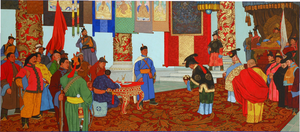More languages
More actions

The Mongolian People's Revolution was a peasant-led socialist revolution in Outer Mongolia in 1921.
Background[edit | edit source]
See main article: Bogd Khanate of Mongolia (1911–1924)
Planning[edit | edit source]
On 1920 November 22, Damdin Sükhbaatar and Khorloogiin Choibalsan returned to Mongolia from Irkutsk and began planning an uprising from Hiagt against the Mongolian feudal nobility led by Baron Ungern and the Bogd Khan. They began publishing the newspaper Mongolian Truth (Mongolyn Ünen), which denounced the imperialists and nobility, and distributed other pamphlets in Mongolia. Sükhbaatar organized 50 border troops in northern Mongolia, and B. Puntsag became the commander of the first revolutionary regiment which was composed of peasants and soldiers. They chose Altan, a town on the Orkhon and Selenge rivers, as their partisan base, and defeated multiple groups of Chinese warlords in Maimachen (now Altanbulag).[1]:286–9
Choibalsan returned to Örgöö from northern Mongolia and prepared for the First Party Congress. On 1921 March 1, the MPRP held the congress in Hiagt with 26 delegates, mostly from the peasantry. Most of the delegates wanted to ally with Russia and remain independent from the nobility, but a few sided with the nobility and believed Ungern had already restored Mongolia's autonomy from China. The Congress also combined all the partisan groups into the People's Revolutionary Army, with Sükhbaatar as its commander-in-chief and Choibalsan as commissar. The party adopted a program calling for the formation of peasant assemblies (hural) and the overthrow of the Russian Whites and the Chinese warlords.[1]:289–91
Hiagt uprising[edit | edit source]
On March 13, a congress of workers and partisans in Hiagt elected the Provisional People's Government of Mongolia, with Chagdarjav as President, Sükhbaatar as Minister of War, and Choibalsan as Deputy Commander-in-Chief for Political Affairs. Bilegsaikhan, Bodoo, and Sumya were also elected. On March 16, the Central Committee and Provisional People's Government sent a message to the 10,000 Chinese soldiers in Maimachen telling them to surrender. They did not respond, and the People's Army attacked two days later and defeated them, expelling the warlords from the country. On March 19, the Provisional Government issued a manifesto declaring the formation of a new government and Grand All-People's Hural. A few days later, it established three ministries: Finance, Internal Affairs, and War.[1]:292–4
Attempted counterrevolution[edit | edit source]
On March 25, the Provisional People's Government sent a letter to Sodnomyn Damdinbazar, the Prime Minister of the Ungern government, calling for negotiations. He did not respond. In order to spread the revolution across the country, the People's Government sent Hasbaatar and Dambadorj to western Mongolia and Chagdarjav to the east. On April 10, Sükhbaatar requested support from Russia against Ungern's forces.[1]:295–6
On May 20, Ungern's forces advanced toward Hiagt and Altanbulag, the headquarters of the revolution. With the support of the Soviet Red Army, the People's Army defeated them and captured Ungern's commander Bayargun. The People's Revolutionary Army began marching toward Örgöö on June 27 and liberated it on July 8. Two days later, the People's Government formally took power. On July 16, a permanent government formed with Bodoo as Prime Minister and Minister of Foreign Affairs, Sükhbaatar as Commander-in-Chief and Minister of War, Danzan as Minister of Finance, Magsarjav as Minister of Justice, and Puntsagdorj as Minister of Internal Affairs. The Bogd Khan retained the title of monarch but no longer held actual power.[1]:297–300
Hasbaatar formed a regional party committee in western Mongolia in May, and Magsarjav led a rebellion in Ulyasatai, killing Ungern's followers. In July, Sükhbaatar's troops battled Ungern's forces near Örgöö while Choibalsan and Puntsag's troops fought them in the north. Ungern and Rezukhin fled into Russia on July 24 and then fled back into Mongolia in August before surrendering. Ungern was sentenced to death in Novosibirsk. By the middle of 1922, all the White forces in Mongolia were defeated.[1]:300–2
